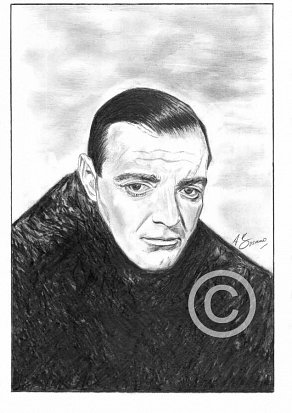Peter Lorre
Pencil Portrait by Antonio Bosano.

Shopping Basket
The quality of the prints are at a much higher level compared to the image shown on the left.
Order
A3 Pencil Print-Price £20.00-Purchase
A4 Pencil Print-Price £15.00-Purchase
*Limited edition run of 250 prints only*
All Pencil Prints are printed on the finest Bockingford Somerset Velvet 255 gsm paper.
P&P is not included in the above prices.



Comments
The first ever Bond villain, Peter Lorre (1904-1964) was born Laszlo (Ladislav) Löwenstein in Rosenberg, a small town in Austria-Hungary about 150 miles northeast of Vienna. He grew up and was educated in Vienna. Seeking parental approval, he became a bank clerk, a position that made him very unhappy before starting his acting career. Despite his father’s objections, Lorre was drawn to the German-speaking stages of Breslau, Zurich, Vienna, and finally Berlin, to which he moved at the age of 21. It was on the stage in the German capital that Lorre drew the praise and attention of German playwright Bertolt Brecht (1898-1956). After years of relative obscurity, Lorre finally made it big with his masterful role as the psychopathic child molester/murderer in Fritz Lang’s first sound film in 1931, the still enjoyable “M”.
Observing the rise of the Nationalist Socialist party, the Jewish Lorre wisely fled Germany in 1933. He worked in Britain, notably for Alfred Hitchcock before eventually settling in America. His bulging eyes, round face, and nasal voice would become familiar to millions of moviegoers in a Hollywood film career that spanned 33 years and ranged from classics like the two great film noir works “The Maltese Falcon” (1941) and “Casablanca” (1942), or Disney’s “20,000 Leagues Under the Sea” (1954) to the respectable if bizarre “Mr. Moto” series (1937-1939), in which the Austrian Lorre played a Japanese detective modeled after the successful Chinese film detective, Charlie Chan.
He featured in many television productions of the 1950s and early ’60s, including an early version of Ian Fleming’s “Casino Royale” and other teleplays for Climax, Lux Video Theater, and Playhouse of the Stars. He even played roles in popular TV series such as “77 Sunset Strip,” “Route 66,” and “Disneyland.” He made a few decent movies in the ’50s and ’60s, but his last really good role had been in the John Huston satire “Beat the Devil” (1953).
Lorre was only 59 when he died but looked considerably older than his years. His somewhat bloated appearance had hinted at health issues and indeed, persistent heart problems in the previous ten years and a lifelong morphine addiction were contributory factors.
One of his most distinctive features was the soft, nasal quality of his voice, tinged with a European accent, which he used with chilling effectiveness. When he was good, he was very good…..